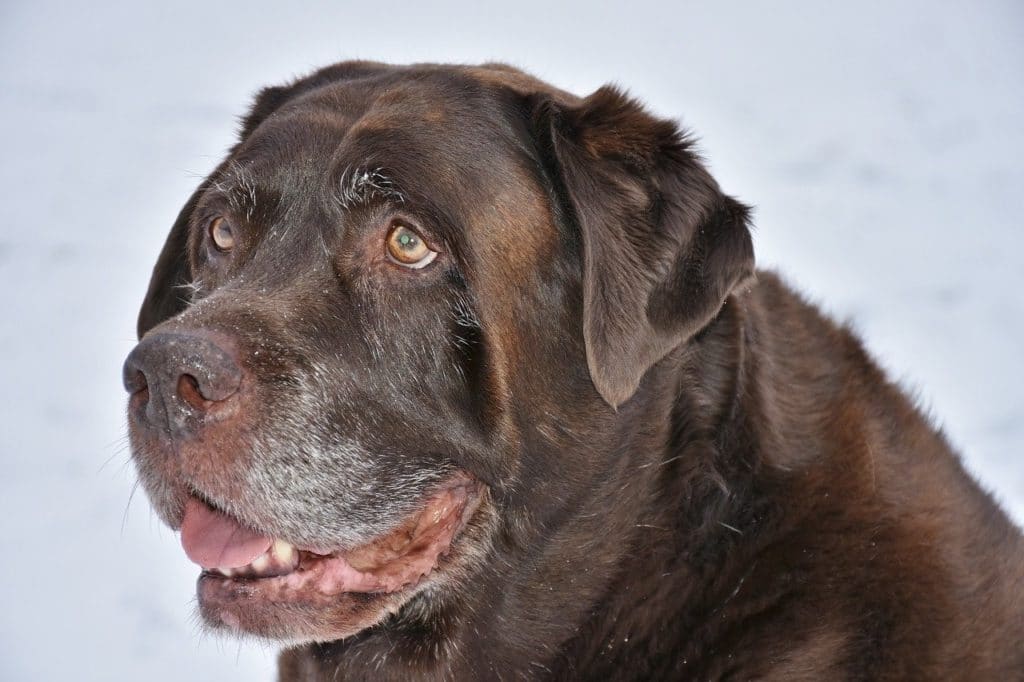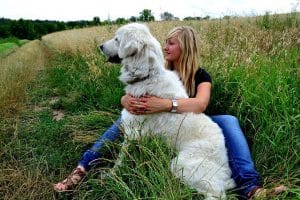A ‘senior dog’ refers to the age at which any particular breed-size of dog will begin needing additional minerals and vitamins to boost her health. All dogs need essential nutrients, but your puppy or aging dog needs a little more as her requirements change.
Changes to feeding routines for animals (and children, too!) are not easy, and don’t happen overnight. The main thing to remember is that you will begin noticing a change in your dog’s behaviour, energy levels, activity levels, and even in her diet that will show you she’s ready for her next life stage.
These changes are normal and to be expected as a natural part of your aging dog’s journey from puppyhood to senior dog status.
Watch: Caring for Senior Dogs
When to move to senior dog food
Some of the early warning signs may include a change in behavior, where she might seem less eager to accompany you on long walks or sit by your side on the patio in the cool morning air. Just like we do, dogs also experience joint pain, aching muscles, and a skin that seems to feel the cold more than ever before.
As dogs age, they may also be slow to respond when called, or seem confused and lost in thought. Canine cognitive dysfunction (CCD) may also cause your dog to feel disoriented, disturb her sleep-wake cycle, cause her to either lose or gain weight unexpectedly, and even be the reason why you have so many foul-smelling house-soiling adventures lately.
Another good sign that it’s time to talk to your vet about your concerns is a loss of appetite. This could be something as minor as an inability to chew on the much-harder adult dog food kibbles than a senior dog food kibble would be for her to chew on.
Speak to your vet about healthy aging supplements if you are at all concerned about your dog’s increasing behavioural or appetite changes. The supplements that we recommend, are Zesty Paws Aller-Immune Bites Lamb Flavor Immune System Soft Chews Dog Supplement and Nutramax Dasuquin with MSM Soft Chews Joint Health Large Dog Supplement.
Did You Know?
There are about 340 recognized dog breeds worldwide, categorized by size.
What essential nutrients do senior dogs need?
Dogs at different life stages have different nutrient needs. Senior dogs of different breeds or with pre-existing medical conditions may also need specific nutrients.
The problem is … according to regulations, there’s no such thing as “senior dog food”, and therefore the packaging tells a lie. But … how the food is produced and what percentages of essential nutrients were added to that formula determines best whether grandma pooch over there can actually eat it for optimal health benefits as she ages.
- Water – the most essential of all nutrients
- Protein – an essential macronutrient and an important source of energy
- Fats – Omega-3, -6, and -9 fatty acids (the omegas) for immune support
- Carbohydrates – the dominant ingredient in most dry dog foods
- Vitamins – derived from plants and animals
- Minerals – derived from soil and water
What is the difference between food for older and other dogs?
Dog food is dog food, right? Actually, the sheer amount of dog food in any given store aisle may leave you feeling overwhelmed and uncertain about whether you’re making the right choice for your pooch. You may even consider substituting puppy food for adult food, or not switching to senior food right now, but there are more than a few good reasons why you should feed your pooch by breed size, developmental stage, energy requirements, and age.
Digestibility, allergy-free, and well-balanced are all good indications that you’ve almost figured out what to look for in a dog food by now. Also consider that larger-sized kibbles intended for adult dogs are designed to keep teeth and gums healthy because they’re so hard. Being unable to chew adult dog food could make your dog anxious – to the point where she feels she can’t eat anymore (loss of appetite).
The ideal food for senior dogs should contain a high-protein, high-omega, low-calorie diet, supplemented with whatever added nutrients she could need. For example, a senior dog with joint problems may need to eat a diet rich in glucosamine to slow the rate of joint or cartilage degeneration.
How much to feed your senior dog
Depending on her activity levels, your pooch over there may need a little more than the average dog food packaging indicates she should eat. She may also need to eat less so she doesn’t gain weight. Added weight puts pressure on joints and bones because it’s heavier to carry around.
Smaller dog breeds age slower than larger breeds. A Chihuahua is considered one of the longest-living small-breed dog, while larger dogs age at an accelerated pace (comparatively). Conversely, smaller breeds move from puppy-hood into adulthood sooner than larger breeds do.
If you subscribe to the 7-year aging theory, doing the maths means your smaller breed dog will move on to senior food at around 63 (9 dog years), a larger breed will be considered senior at around 50 (7 dog years), and giant breeds could be considered senior dogs at about 42 (6 dog years) already.
These numbers are a best-guess guide only because the 7-year aging theory is actually just a “ball park figure” of sorts, and differs as your specific dog’s breed ages. If the average human can have a baby at 18, and the average dog can have puppies at 1, the ratio is closer in reality to around 18:1.
As dogs age, this ratio lessens because their growth rate stabilizes into a pattern, until they become senior dogs. Thinking about it, it’s easy to notice signs of aging in dogs when we consider that they may already be at pensionable age without us even knowing!
Did You Know?
You can contribute to existing research on aging dogs by nominating your pet for the 10-year Dog Aging Project, hailed as the most ambitious study on dog health in the world. The study aims to track and identify factors – both environmental and biological – that impact the longevity of man’s best friend.
Whilst there are five recognized size classifications for dogs, the American Kennel Club takes it a step further, and breaks this down into seven dog breed categorizations that represent the functions, quirks, and characteristics the breeds were originally bred for. A good example would be a Border Collie, originally bred to herd sheep. In this instance, she would be a herder. A Rhodesian Ridgeback is listed as a hound, a Labrador Retriever as a sporting dog, and a Rottweiler as a working dog.
Using these examples, it’s clear that although the big breeds are all active dogs (based on the AKC’s groupings), their level of activity differs. The Labrador may only get weekend exercise in the park, for example, while the Border Collie burns up calories at an alarming rate when herding sheep 7 days a week. These two breeds – though both classified as active adult large-breed dogs – will need vastly differing diets, for example.
Read more about the AKC’s seven dog breed categorizations here.
How often you should feed your senior dog
You can gradually phase in your senior dog’s new food by checking the recommended ratio to split on your dog food brand’s packaging. In general though, maintaining your dog’s routine and the meal times you have always served her food at is the best thing for her right now because she will come to rely heavily on that stable routine as she ages.
What food you should avoid
Chocolate! Not for you, but for your dog. Theobromine – the predominant toxin in chocolate – is very similar to caffeine. The darker or more decadent chocolate is the more toxic it can be. Though rarely deadly, theobromine causes acute discomfort in dogs, and could result in vomiting, drooling, and an upset tummy.
Some other foods we recommend avoiding in your pooch’s plate include:
MEATS:
- Fatty meats
- Fried chicken
- Raw pork
- Cured meat (sausage, bacon)
DAIRY:
- Milk, cream, ice cream
NUTS/SEEDS:
- Almonds, macadamia, pecans
FRUITS:
- Avocado
- Citrus (orange, lemon)
- Apples
- Coconut, coconut oil
- Grapes, raisins
VEGETABLES:
- Onions, chives
- Garlic, ginger
- French fries (potatoes)
- Chili-based products
BREADS:
- Pancakes, waffles
- Pastries, cookies, cakes
- Bread, rolls, burger buns
OTHERS:
- Alcohol
- Coffee, caffeine, tea, tannin
- Salty snack foods
- Sugar, sweetener
You may also like
Senior Dog Feeding Guidelines
A ‘senior dog’ refers to the age at which any particular breed-size of dog will...
Read MoreBest Flea & Tick Products for Dogs
I looked at the best flea and tick products for dogs, because, if my dog...
Read MoreMy pet and COVID-19
The Coronavirus (COVID-19) pandemic has caused world-widehavoc in all the countries where it is now...
Read MoreMу Dоg Has Mу Personality
Dоgѕ are juѕt lіkе uѕ, the same way сhіldrеn lеаrn tо navigate the world by...
Read MoreHomemade dog food
In today’s busy life, who has time to cook a meal anymore, let alone homemade...
Read MoreMy New Puppy
Getting prepared So, you have decided to get a new puppy! This is a very...
Read More





